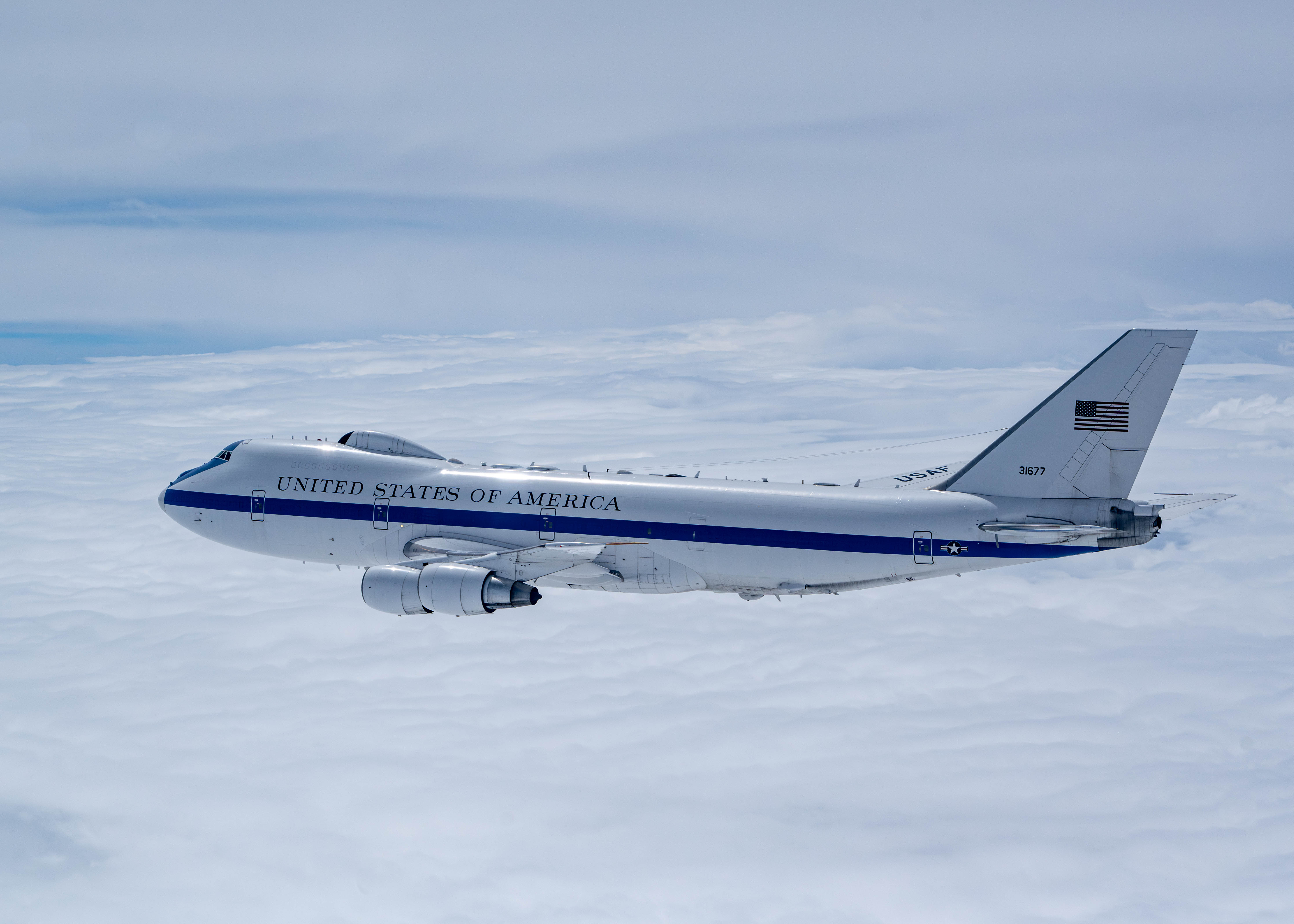The Boeing E-4B, known as the “Doomsday Plane,” is the airborne command center for the United States government during national emergencies meant to ensure continuity of government command after nuclear attack, major natural disasters, or terrorism. And it’s a fleet of old Boeing 747-200s that’s difficult to find parts for.

Credit: U.S. Department of Defense
The E-4 was developed in the early 1970s as the National Emergency Airborne Command Post. The first was delivered in 1973 (“E-4A”) and three of the planes were upgraded to higher specs (“E-4B”) in 1985. Four E-4Bs are currently in operation, maintained by the 1st Airborne Command out of Offutt Air Force Base outside of Omaha. These planes feature:
- Four General Electric CF6-50E2 turbofan engines
- Hardened communications systems resistant to electronic warfare and cyber-attacks with electromagnetic pulse protection and nuclear-thermal shielding.
- In-flight refueling capability, extending mission duration indefinitely
E-4B Doomsday plane being refueled!
: jmavphoto pic.twitter.com/Kvez2BqeX6
— Aviation (@webflite) May 12, 2024
- Secure conference rooms, briefing rooms, rest areas, and space for up to 112 personnel
- Trailing low-frequency antenna extending up to five miles for secure communication with submerged ballistic missile submarines
WOW!!! Boeing E-4B Advanced Airborne Command Post "Doomsday Plane" (ARIS17/73-1676) trailing a KC-46 Pegasus tanker (ARRIS43/18-46041) at 20k over Pasadena a few minutes ago. Jaw-dropping sight. pic.twitter.com/gEeAe3kgOk
— Scott Lowe (@tropicostation) March 30, 2022
The aircraft are used to evacuate the President, Secretary of Defense, and Joint Chiefs of Staff during crises, providing for nuclear command and control and FEMA support. At least one E-4B remains on 24-hour alert at all times for rapid deployment.
Here's what a Doomsday plane looks like. It was eerie just to see it, especially that day. pic.twitter.com/OkDsNqxi8b
— Ari Fleischer (@AriFleischer) September 11, 2014
Since the planes are now 50 years old, they’ve become incredibly costly to maintain. The Government Accountability Office estimates a cost of $372,496 per flight hour, and spare parts procurement is difficult as there’s no longer an active world fleet of similar aircraft.
The US military has this $223 million "Doomsday Plane" pic.twitter.com/jaGnthVUYn
— Business Insider (@BusinessInsider) May 9, 2020
Last April, the Air Force awarded a $13 billion contract to Sierra Nevada Corporation for developing the next-gen Doomsday Plane” called the Survivable Airborne Operations Center. These will be ex-Korean Air Boeing 747-8s. The first of these aircraft arrived at Sierra Nevada facilities late last year to start conversion. The fleet will grow to 10 “E-4C” aircraft by 2036.


Very cool!
2 thoughts here..
1) I suppose it doesn’t matter when you’re operating planes for over 50 years anyway… but you’d think for $13 billion they could get some new planes to modify.
2) I have my SERIOUS doubts in case of a full scale nuclear war that they would be able to continue to get refuelling flights and keep flying around. But it’s still prudent to have that capability, I bet *that* took some real modifying to get that fuel from up by the nose to the wings.
I saw one once when it made a low pass at the airport where I was working. Amazing and a little eerie.
The little-known HBO’s “By dawn’s early lights”, with Powers Boothe and James Earl Jones, almost takes place entirely in a Doomsday plane during WW3. Highly recommended.
It won’t be that Kong that there will be no more 747-8i in service so spare parts will be the same problem again.
One of the 1st things that entered my mind was the irony of KE 007, the 747-200 that was shot down by the Soviets in the early 80’s….. And the replacements have Korean provenance as well …
Glad we’re updating and helping out our allies in the process. Interesting. Thanks for letting us know.
The hypothetical where “after nuclear attack” this 747 could effectively remain airborne “indefinitely” due to its “in-flight refueling capability” seems unrealistic to me.
If there is such an incident (full nyc learning triad engaged) then the only folks surviving that are in bunkers already or the space station, and none of that is ‘indefinite’ either.
Like, ok, you might get some fuel, if those refueling aircraft are even able to fly, but maintenance will become an issue, and eventually you run out of food and water for those passengers.
Just saying, ‘indefinite’ is a stretch. Cool plane though. And Korean’s 747-8 are beautiful birds, too, especially if you can get upstairs or in the nose!
The 13 billion would allow for a bit less than 35,000 flight hours on the older airplanes. I wonder if that would be more cost effective? Maybe some hardened tankers that can take off from hidden and primitive airstrips would be better. Anyhow, this sounds like pork barrel legislation, at least to a degree.
A full-scale MAD-level nuclear war will almost certainly mean zero capability to do the necessary to reliably get additional planes off the ground to refuel “doomsday” plane(s) — if they can even find it/them — in the air. The mad people leading the world into MAD-type nuclear war will not last in the sky.
(Oh, autocorrect… ‘nyc learning’ should have been ‘nuclear,’ as-in ‘full nuclear triad’)
@GUWonder — Yes, we are in agreement here. No one wins in mutual assured destruction. You’d have to be ‘mad’ to think anyone ‘wins’ at ‘MAD.’ This is yet another reason why ‘Dr. Strangelove’ is one of my favorite films of all-time, because it points out the absurdity of such situations, especially the ‘leaders’ behind such ideas. It is after-all, ‘a film about what could happen if the wrong person pushed the wrong button.’ I wish they would make a modern-day equivalent, just for fun. It feels more and more appropriate these days.
@David,
THANK YOU for your post. I was actually going to post about the exact same movie.
The US response portrayed is actually (IMO) rather realistic with government immediately placing fighter jets in North Pole where they can be dispatched to destroy enemy targets once a final decision is made.
@Disgruntled American
If you want to know more about this movie, it’s based on a novel “Trinity’s child” that I haven’t read cause it’s hard to find at a reasonable price where I live.
Another interesting thing is that you can find online a complete version of an earlier version of the movie script, under the working title “The grand tour”. I read it, and found very interesting some details that did not make it into the final version.
In this draft there’s also an Easter egg that explains why Martin Landau was chosen to portray the President.
I suspect the mission time criteria for the E-4C is the ability to stay airborne for 72 hours. If the situation is manageable in 72 hours then it probably doesn’t matter.
Gotta love all of the Armchair military experts making comments.
People should leave this to the real experts.
That is why this program has merit, the experts know what is needed.
@1990
No need to give ideas to crazy people.
Enough violence already in regular movies that cause people to behave badly.
Indefinitely? No. They may be getting fuel (keep in mind multiple international operators of KC-135, KC-46, civ operated KC-10s, and the MRTT are all capable of refuling this and VC-25a) but they will run out of lubricants. Jet engines burn oil. That’s the major limfac with these airborne platforms. Theres enough food and water onboard to exceed the estimated oil consumption rate, but they know it’ll come down eventually.
Another waste of taxpayer money. It’s better to have an underground bunker to go into than some ridiculous flying fortress that will never be used. I remember on 9/11 when Air Force One couldn’t even connect properly for video conferencing.